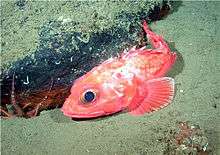Shortspine thornyhead
| Shortspine thornyhead | |
|---|---|
 | |
| Scientific classification | |
| Kingdom: | Animalia |
| Phylum: | Chordata |
| Class: | Actinopterygii |
| Order: | Scorpaeniformes |
| Family: | Sebastidae |
| Genus: | Sebastolobus |
| Species: | S. alascanus |
| Binomial name | |
| Sebastolobus alascanus T. H. Bean, 1890 | |
The shortspine thornyhead (Sebastolobus alascanus) is a species of fish in the Sebastidae family. It is sometimes referred to as the "idiot fish" or "idiot cod" due to its large oversize head/eyes. It is found in Canada, Russia, and the United States. Adult S. alascanus live predominantly in the oxygen minimum zone (OMZ), and thus require specific adaptations/exaptations in order to overcome the problems posed by the extremely low levels of oxygen saturation. Allowing for an increased ventilation frequency during exposure to progressively hypoxic conditions, as compared to its more shallow relative Scorpaena guttata, enables S. alascanus to compensate for the inherent low concentrations of oxygen in the OMZ. Further, heightened levels of lactate dehydrogenase, specifically the anaerobic isoform- LDH-A in the heart and muscles of S. alascanus, suggests an adaptive mechanism for ATP production during low oxygen availability.
Description
The shortspine thornyhead has a large head with a strong spiny ridge, and an elongate, tapering body which grows to a maximum length of 80 cm (31 in). The dorsal fin has 15 to 17 spines and 8 to 9 soft rays and the anal fin has 3 spines and 4 to 5 soft rays. There is a deep notch in the pectoral fin and the caudal fin is rounded. The general color of this fish is bright red with varying amounts of black on the fins and a pale-colored gill chamber. This fish may live for 100 years.[2]
Distribution
The shortspine thornyhead is native to the cold waters of the northern Pacific Ocean and is known from Canada, Alaska and the Russian Federation. Its depth range is between 17 and 1,600 m (56 and 5,249 ft) but it is more usually found at depths less than 100 metres (330 ft).[2]
Status
Although this species used to be very common on soft bottoms, a commercial fishery began in 1967 and the fish has been overexploited since then, resulting in the IUCN assessing it as being "Endangered".[1]
References
- 1 2 Bell, T. & Guttman, A. (2000). "Sebastolobus alascanus". IUCN Red List of Threatened Species. Version 2013.1. International Union for Conservation of Nature. Retrieved 2013-12-20.
- 1 2 "Sebastolobus alascanus Bean, 1890: Shortspine thornyhead". FishBase. Retrieved 2013-12-20.
- Yang, et al. (1992). "Respiratory, Blood, and Heart Enzymatic Adaptations of Sebastolobus alascanus (Scorpaenidae; Teleosti) to the Oxygen Minimum Zone: A Comparative Study". Biological Bulletin 183: 490-499.
